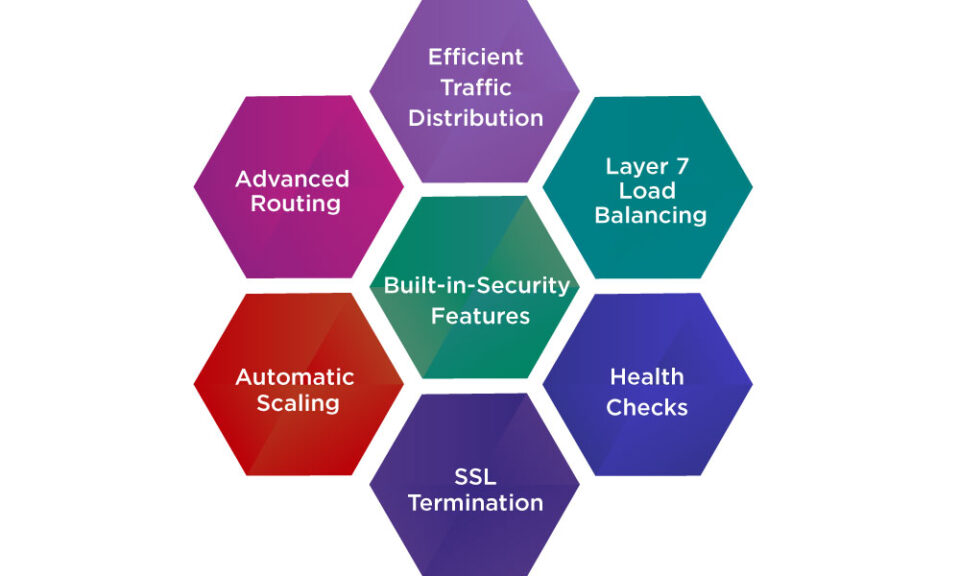In a cloud setup with various web services, load balancing is crucial. It spreads out the network traffic and data across several servers, so no single server gets overwhelmed. This makes applications faster and more reliable, improves user experiences, and helps defend against DDoS attacks. In this blog, we will explore what application load balancer is and its features.
What is an Application Load Balancer?
Application load balancer is a load balancing service that distributes incoming traffic across multiple targets automatically, such as EC2 instances, containers, and IP addresses. It observes the health of its registered targets and routes this traffic to the healthy ones.
Application load balancer provides various benefits over classic load balancer, including support for path –based and host-based routing, HTTP header-based routing, and registering targets by IP address or Lambda functions. It also integrated with other AWS services like EC2, auto Scaling, CloudWatch, and Route 53 to increase the availability and scalability of your applications.
For example, an Application Load Balancer can be visualized as a traffic manager for your website or application. Imagine a busy restaurant with many guests. Instead of letting everyone crowd at the entrance, the host directs guests to different tables to ensure everyone gets served quickly and efficiently. In a very similar way, an ALB manages incoming internet traffic (HTTP or HTTPs) and distributes it across multiple servers, ensuring your application remains fast and responsive.
Key Features of Application Load Balancer

1. Efficient Traffic Distribution: This is the primary function of an ALB which distributes incoming traffic in a group of servers. This helps prevent cases wherein one server floods due to excess traffic and leads to slow performance or system crashes. Keeping the load helps ALBs ensure that your application performs well, even at peak times.
2. Layer 7 Load Balancing: In ALB, the layers used are at the application level. This means routing decisions can depend on content contained in a request, such as URL paths or HTTP headers. For example, one set of servers can be routed for processing requests for images, while another set can be picked for processing requests for data. Thus, this boosts performance and resource usage.
3. Health Checks: ALBs continuously monitor the health of their servers. If a server becomes unresponsive, the ALB automatically redirects traffic to healthy servers. This ensures that users always experience minimal disruption and that their requests are handled reliably.
4. SSL Termination: Secure Sockets Layer (SSL) encryption is used to safeguard data that flows over the internet. An ALB can be configured to support SSL termination-that's decrypted incoming traffic forwarded to your servers. This way, decryption occurs elsewhere, offloading from your instances, enhancing performance, and simplifying certificate management.
5. Automatic Scaling: As traffic to your application increases, an ALB can work in sequence with cloud infrastructure to automatically scale up or down resources. This means you don't have to make manual changes to the number of servers based on traffic patterns. The ALB will adjust in real-time and then redistribute traffic for optimal performance regardless of demand.
6. Advanced Routing: ALBs support advanced routing rules based on URL paths, hostnames, or HTTP methods. It enables you to forward the traffic to appropriate servers as per the content of the request. For example, you may use this feature to route your main site traffic to one set of servers and the blog or support portal traffic to another.
7. Built-in-Security Features: Application Load Balancers have multiple built-in security features. These include integration with web application firewalls (WAF) for protection of your application from common web threats like SQL injection and cross-site scripting. Additionally, they support access control lists (ACLs) to limit traffic from certain IP addresses or geolocations.
How Does an Application Load Balancer Operate?
A request from the user to your application is passed through the ALB. ALB receives the request and decides on a request that needs to be catered to based on predefined routing rules. A request goes to one of the available servers based on both content and routing rules in place. The ALB redirects traffic to another server if one of the servers is overloaded or unhealthy, ensuring users enjoy a fast, reliable experience.
Why Choose an Application Load Balancer?
Enhanced Performance: Distribution of traffic across multiple servers prevents one server from becoming a bottleneck and thus generally improves the overall application performance and responsiveness.
Increased Availability: ALBs increase the reliability of your application, with the system automatically handling traffic when some servers fail. With such redundancy, you decrease downtime and increase service availability.
Scalability: As your application grows, an ALB can easily adapt to handle increased traffic, thanks to its integration with cloud platforms that allow for automatic scaling.
Flexibility: With advanced routing and configuration options, ALBs enable tailored traffic management to fit your specific needs, optimizing resource use and user experience.
Improved Security: Features like SSL termination and security tool integration help protect your application and user data from various threats.
Summing Up!
Application Load Balancer is a good traffic manager and optimizer for web applications. They help in ensuring your application is fast, reliable, and secure by distributing the traffic evenly, handling SSL encryption, and providing support for advanced routing rules. As your user base grows and traffic patterns shift, an ALB gives exactly what you need, which is scalability and flexibility. This ensures users remain positively engaged with your application. This will generally enhance the performance and reliability of your application if performed correctly, so use this knowledge to understand and eventually implement an ALB.
To know more about application load balancers and their types, visit us at WisdomPlexus!
Recommended For You:




